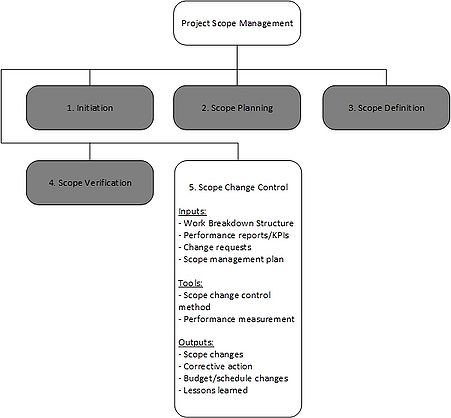Project Scope Control
| Line 22: | Line 22: | ||
These above processes do interact and interface with each other. The articles focus is now shifted towards Project Scope Control. The purpose of this process is to ensure that scope changes are beneficial to the project, determine whether or not a scope change has occurred and finally managing the changes as they occur. Changes to project scope may have direct or indirect influence on the project cost, schedule, quality and others. Therefore, it is important to ensure any implications are accounted for. Scope Change Control is a process flow including inputs, tools and outputs. | These above processes do interact and interface with each other. The articles focus is now shifted towards Project Scope Control. The purpose of this process is to ensure that scope changes are beneficial to the project, determine whether or not a scope change has occurred and finally managing the changes as they occur. Changes to project scope may have direct or indirect influence on the project cost, schedule, quality and others. Therefore, it is important to ensure any implications are accounted for. Scope Change Control is a process flow including inputs, tools and outputs. | ||
| + | |||
| + | [[File:Project Scope Change Control Process.jpg|thumb|center|723x95px|Figure 2: Project Scope Change Control Process, inspired from the PMBOK® Guide]] | ||
| Line 40: | Line 42: | ||
<li>'''Change Request:''' These requests are made by the proposer, which could be for example be the Project Owner or external engineering partner. | <li>'''Change Request:''' These requests are made by the proposer, which could be for example be the Project Owner or external engineering partner. | ||
</ol> | </ol> | ||
| − | |||
==Application== | ==Application== | ||
Revision as of 12:52, 22 September 2017
Contents |
Abstract
As the project scope continuously develops, it is essential that projects have a clear scope management process, which defines how scope is to be defined, developed and managed. This is the process of monitoring the status of the project and product scope and managing changes to the scope baseline. The key benefit of this process is that it allows the scope baseline to be maintained throughout the project. This process captures changes in the project's budget and schedule. Project scope is defined as the "work required to output a project’s deliverable."[1] A Scope Change is a change in the agreed scope and goals of a project to address a need not originally defined to be part of the project. This includes processes for requesting, reviewing, approving, carrying out and controlling changes to the project's deliverables. The main stakeholders involved in Scope Change Control include, the proposer of the change, Work Package Owner (WPO) and potentially a second approver, which could for example be the Project Director.[2] This article focuses on the method of applying Scope Change Control, based on industry best practices through structured interviews with Project Managers and Engineering Managers. For the sake of clarity, this method is applied to construction projects within the pharmaceutical industry.
Background
According to the PMBOK® Guide, a body of project management standards and guidelines, the purpose of Project Scope Management is to ensure that the outcomes of a project are successfully achieved by only including all the necessary work to complete. Therefore, Project Scope is defined as the work that must be done in order to achieve desired project deliverables.[3]
Figure 1 gives an overview of Project Scope Management. It includes five process:
- Initiation: Engaging and committing the organization or project office to start the project
- Scope Planning: Developing a scope statement that set the course for future decision making
- Scope Definition: Breaking down major deliverables into manageable sizes, also known as Work Breakdown Structures (WBS) to be executed by the Project Team.
- Scope Verification: Verifying or accepting the scope statement
- Scope Change Control: Controlling changes to the project scope
These above processes do interact and interface with each other. The articles focus is now shifted towards Project Scope Control. The purpose of this process is to ensure that scope changes are beneficial to the project, determine whether or not a scope change has occurred and finally managing the changes as they occur. Changes to project scope may have direct or indirect influence on the project cost, schedule, quality and others. Therefore, it is important to ensure any implications are accounted for. Scope Change Control is a process flow including inputs, tools and outputs.
The inputs of Project Scope include:[4]
- WBS: The breakdown of project elements into groups that define the project scope. The purpose is to define confirm a common understanding of the project scope baseline.[5]
- Performance Reports/KPIs: Performance reporting is used to alert the project team of potential issues regarding scope
- Change Request: These requests are made by the proposer, which could be for example be the Project Owner or external engineering partner.
The inputs of Project Scope include:[6]
- WBS: The breakdown of project elements into groups that define the project scope. The purpose is to define confirm a common understanding of the project scope baseline.[7]
- Performance Reports/KPIs: Performance reporting is used to alert the project team of potential issues regarding scope
- Change Request: These requests are made by the proposer, which could be for example be the Project Owner or external engineering partner.
Application
limitation
References
- ↑ https://www.pmi.org/learning/featured-topics/scope Project Management Institute. Retrieved 18 September 2017.
- ↑ Meeting with Project Managers within the pharmaceutical industry.
- ↑ Page 47, 1996 ed. PMBOK® Guide
- ↑ Page 57, 1996 ed. PMBOK® Guide
- ↑ Page 54, 1996 ed. PMBOK® Guide
- ↑ Page 57, 1996 ed. PMBOK® Guide
- ↑ Page 54, 1996 ed. PMBOK® Guide

